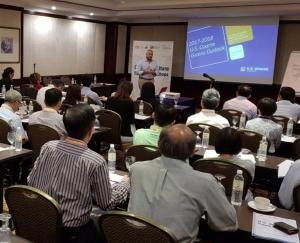The U.S. Grains Council (USGC) and the U.S. Soybean Export Council (USSEC) joined forces this month to put on two one-day workshops for Southeast Asian buyers looking for the latest in market and harvest information and details about how U.S. agricultural products can benefit their businesses.
Manuel Sanchez, USGC regional director for South and Southeast Asia, provided timely insights on the 2017/2018 coarse grains outlook, while other presenters provided outlooks on the global overview for grains and oilseeds.
Additional topics covered included the opportunities and challenges for the region’s agricultural industry and consumption trends for major products. A commitment to quality and continued improvement in production practices was also communicated and well-received by the buyers in attendance.
In particular, the workshops emphasized a program called “Animal Nutrition 101,” a basic introduction to help non-technical personnel better understand the quality and value in U.S. agricultural products. Attendees heard technical presentations focused on the fundamental concepts of animal nutrition as well as the importance of matching nutrients from the major feed ingredients, like soybean meal and feed grains, to the nutritional requirements of poultry and livestock in order to manage feed cost, achieve better animal performance and improve profitability.
“Attendees appreciated the easy-to-understand introduction to animal nutrition for a non-technical audience,” Sanchez said. “These workshops benefited from strong interest from the major grain traders and importers in the region.”
A workshop held in Singapore included 35 participants from 13 different trading companies, which collectively represented more than 80 percent of the agricultural commodity trade flows into South Asia. In addition, more than 40 industry representatives and members of the Malaysian Feed Mill Association attended the second workshop in Malaysia.
“The workshops received excellent feedback with the vast majority of attendees rating the content as of high value,” Sanchez said. “Most welcomed the broad but comprehensive information provided as well as the interaction with other members of the trading community.”
According to the World Economic Forum on ASEAN, rapid population growth and climate volatility are projected to push up demand for food in the Southeast Asian region by 40 percent by 2050. The Council includes Brunei, Cambodia, Malaysia, Myanmar, the Philippines, Singapore, Thailand, Vietnam, Indonesia, Australia and New Zealand in the Southeast Asian region. Together, these countries represent a large and growing market for feed grains and co-products that the Council is working to help build and capture for U.S. producers through educational efforts like this month’s workshops.
Learn more about the Council’s work in Southeast Asia here.


